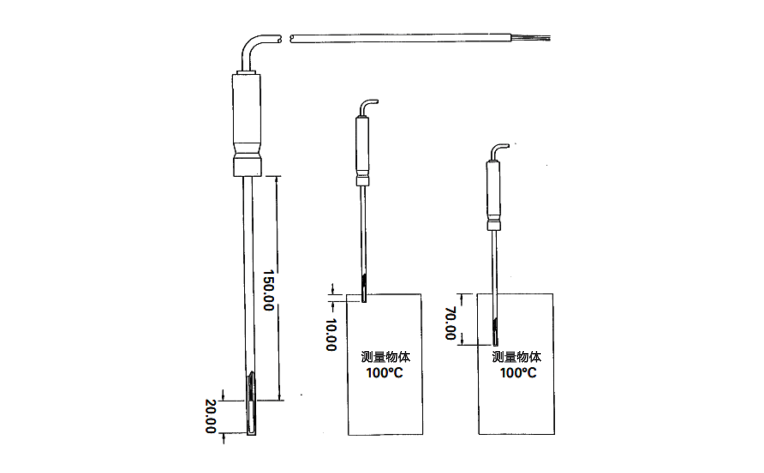
 Error source of resistance temperature sensor (RTD)
Error source of resistance temperature sensor (RTD)
Immersion error - stem conduction
When calibrating industrial platinum resistance thermometers (RTD temperature sensors), valve stem conduction is likely to be the main error source.
Immersion or stem conduction errors are caused by heat flow along the thermometer jacket. If the thermometer is immersed in a hot object, the heat will flow from the body to the surrounding environment along the thermometer sheath. Conversely, if the thermometer is placed in a body that is colder than its surroundings, heat will flow through the jacket into the cool body. The temperature distribution along the rod may cause errors.
The following figure shows a thermometer with an internal sensing element of 20mm. The immersion of the thermometer is only 10mm, which is obvious. The thermometer will not reach the temperature of the human body. The important question is, how far should the thermometer be immersed to eliminate the immersion error? This will depend on various factors, including the characteristics of the thermometer and the temperature difference between the stem and the target body.

Various methods or mathematical models have been proposed to calculate the error, but the number of variables involved makes it difficult to calculate the error in practice. From a practical point of view, it is best to immerse the thermometer in water as much as possible, and carry out the experiment by taking out the thermometer and observing any effect. It has been suggested that, for metal block baths, according to experience, thermometers should be inserted into blocks with a length equal to the length of the detector plus an amount equal to 15 times the diameter of the thermometer.
For the calibration of industrial PRT in the metal block bath, this may be the main source of error and will affect the uncertainty of calibration.
Lead resistance
In a sense, resistance thermometers are "two-wire" devices. When the extension wire is connected to the sensing resistor, the complete thermometer can be changed into a two wire, three wire or four wire connection.
Avoid using two-wire equipment as much as possible. The extension wire becomes a part of the thermometer. As the lead wire length becomes longer, the lead wire resistance error will become larger.
Three wire devices can be used to largely overcome errors introduced by extension cords. Such devices can be easily connected to the circuit, so that the resistance of the wires cancel each other. However, due to the change of the resistance of a single wire, there is still a slight error.
Four wire connections provide further improvements, but industrial instruments do not always have input connections designed specifically for four wire connections, although laboratory instruments usually do.
Thermal hysteresis
The error caused by thermal hysteresis is caused by the delay of thermometer response to temperature change. There is also a mathematical model for this effect, but in fact the time constant of industrial thermometers is usually unknown.
For thermometers, which are closely matched in the pocket of the metal block bath (which shows good temperature stability), it will be common for thermometers to reach their final value in a few minutes. For new or unknown sensors, simple observation is the best way to confirm this.
Heat capacity
When the thermometer is placed in a metal block bath, heat will flow into or out of the thermometer. This loading of the block may cause the temperature of the block to change, although the temperature controller of the block will compensate to some extent.
The recommended method of measuring the plug-in temperature using a standard block bath and an external thermometer can keep such errors to a minimum. Ideally, the heat capacity of the block bath should be greater than that of the probe, which is the case for all probes except the largest industrial probe.
Self heating
Measuring the resistance of the prt temperature sensor requires current to pass through the sensing resistor. The resultant power (I 2 R) dissipated in the temperature sensor is often warned. In practice, it is unlikely to cause significant errors for industrial probes equipped with modern instruments.
The traditional temperature calibration measurement current using the dry block bath 13 is 1mA, but modern instruments tend to use much smaller values to minimize any self heating, which may lead to other more serious DC errors. Users of laboratory standard platinum resistance thermometers need to be more careful to eliminate self heating errors.
DC error
Due to the thermoelectric effect caused by connecting different metals in the structure of prt, a small dc voltage may be generated in the prt. For example, the copper platinum junction can generate an electromotive force of 6 to 8 µ V/º C. Although laboratory instruments may use measurement techniques to eliminate such errors, the resulting offset voltage can lead to errors in related instruments.

